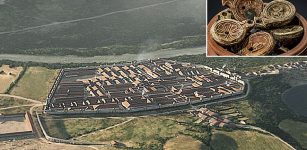Mysterious Stone Age Labyrinth Discovered In Denmark – Was It An Ancient Sun Worship Site?
MessageToEagle.com – A mysterious Stone Age labyrinth has been discovered at Stevns in Denmark. For the moment, it remains unknown why the labyrinth was constructed and what purpose it served.
Discovered by archaeologists from the Museum Southeast Denmark, this particular fence dates from the Neolithic period and seems to frame an oval area of nearly 18,000 square meters.
“It was actually somewhat overwhelming to experience that it is possible to reveal the traces of such a huge building from the Neolithic period. There are many suggestions for what they could’ve been used for, but to put it simply, we just don’t know,” says archaeologist Pernille Rohde Sloth who leads the excavation.
It is not the first time a palisade enclosure has discovered found in Scandinavia. Similar constructions have previously been found in East Zealand in Denmark], on Bornholm, Skåne , Sweden, and possible also in Falster, south east Denmark.
Somewhat puzzling about the newly unearthed labyrinth at Stevns is the is the way the entrances have been constructed. The fence is in fact built in five rows that extend outwards, and the opening in each row appears to be offset from the others.
Sloth suspects the uneven design was deliberate.

“The openings don’t seem to sit next to each of the post rows, and we’re slightly amazed by that. But maybe it functioned as a sort of labyrinth–at least that’s how we imagine it. That way you weren’t able to look inside the common space, which may have been an advantage,” she says.
The most intriguing question is: What was going on inside the enclosure that was so secret?
That is a question archaeologists cannot yet answer because they haven’t been able to find any structures or construction in the area that could point them towards any possible purpose for the enclosure.
Excavations in the area have resulted in the discovery of single pits of various sizes containing flint tools, waste, and some ceramic fragments.

“A palisade construction is typically built for protection, but we don’t think that that is what the construction at Stevns is. The rows of poles would have been around two metres high and weren’t very close together, so you could probably squeeze through them if you wanted to. We believe that it was some kind of fenced gathering area, but it’s difficult to say what it was used for,” says Sloth.
See also:
Intricate Mazes And Labyrinths: Mysterious Symbols Of Beauty And Confusion Or Communication Signals
Spectacular 5,000-Year-Old Stone Map Discovered In Denmark Sheds New Light On Ancient Farming
Mystery Of The Black Forest Egtved Girl: She Was Not From Denmark
We cannot exclude the possibility the labyrinth had a ritual purpose. In 1988, on the Danish island of Bornholm in the Baltic Sea, scientists discovered a large palisade built of timber. At the site they also found a Sun temple containing various sun symbols. A similar temple was discovered elsewhere on the island. It may be that these sun temples only exist on Bornholm, but head archaeologist at the Bornholm Museum, Finn Ole Sonne Nielsen, does not rule out that the enclosure at Stevns could contain similar finds.
“It could well have had a ritual purpose. What’s really exciting about this place is whether [they] find something else in the enclosure similar to our Bornholm discoveries. It would not surprise me if it was a temple area. It would have enclosed something and I think that these temples were much more widespread than we tend to believe,” says Nielsen.

The main difference between the Bornholm palisade and the one found at Stevns is that the poles are located much closer together in Bornholm, which was probably built before Stevns.
Preliminary analysis of the ancient pottery found at Stevns dates the site to the latter part of the Middle Neolithic Funnel Beaker Culture from 2900 BCE to 2800 BCE. The Bornholm sites are even older.
For now, without further excavations it’s impossible to offer anything but speculations as to the purpose of the ancient labyrinth in Denmark. Archaeologists will continue their work and hopefully they will find some more answers to this mysterious site.
MessageToEagle.com
Expand for references









